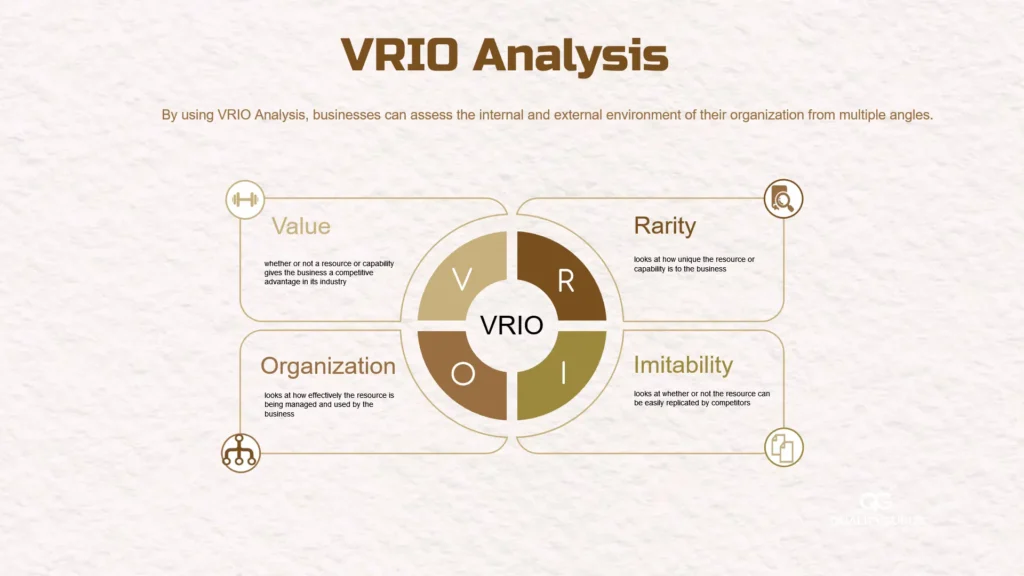Hello, students! As you embark on your academic and professional journeys, you’ll encounter a variety of concepts and frameworks designed to help you understand how businesses operate and compete.
One such tool is the VRIO framework, a strategic analysis method that can seem a bit abstract at first. But don’t worry—once you see how companies like Google, Apple, and Amazon use VRIO to secure their competitive advantages, it’ll start to make a lot more sense.
In today’s blog post, we’ll break down the VRIO framework with real-world examples, helping you grasp how this powerful tool can be applied both in your studies and in the business world.
Google (Technology Industry)
Resource/Capability: Proprietary Search Algorithm
Value: Google’s search algorithm is central to its core business—delivering relevant search results to users. This capability is valuable because it drives user satisfaction, which in turn attracts advertisers. The effectiveness of the algorithm directly impacts Google’s ad revenue, which constitutes the majority of its income.
Rarity: While there are other search engines, Google’s algorithm is particularly rare due to its unparalleled ability to deliver accurate and timely results. The algorithm incorporates complex machine learning models that improve over time with the accumulation of vast amounts of data, making it unique in its precision and efficiency.
Imitability: Google’s algorithm is difficult to imitate because it is built on years of research, development, and data accumulation. Competitors may try to replicate it, but the underlying technology and data infrastructure are too advanced and resource-intensive for most to match.
Organization: Google has structured its entire business model around optimizing and leveraging this algorithm. The company invests heavily in R&D, employs top-tier engineers, and fosters a culture of innovation to continuously enhance its search capabilities.
Outcome: Sustainable competitive advantage. Google’s search algorithm remains a cornerstone of its dominance in the search engine market, driving its ability to maintain a leading position in digital advertising.
Apple (Technology Industry)
Resource/Capability: Brand Loyalty and Ecosystem
Value: Apple’s brand is incredibly valuable because it translates into a loyal customer base that consistently purchases new products. The Apple ecosystem—where devices like the iPhone, iPad, Mac, and Apple Watch work seamlessly together—adds further value by enhancing user experience and convenience, encouraging repeat purchases within the ecosystem.
Rarity: Few companies have cultivated such strong brand loyalty combined with an integrated product ecosystem. Apple’s ability to create a cohesive experience across its devices and services is rare, setting it apart from competitors who may excel in one product category but lack the integration across multiple products.
Imitability: Apple’s ecosystem is difficult to replicate due to the high level of design and software integration required. Competitors might create similar devices, but achieving the same seamless experience across a range of products, coupled with Apple’s brand prestige, is extremely challenging.
Organization: Apple is organized to maximize this capability through a unified design philosophy, tight control over both hardware and software, and a strong marketing strategy that reinforces the brand’s premium image. The company also benefits from a highly efficient supply chain that supports its ecosystem strategy.
Outcome: Sustainable competitive advantage. Apple’s brand loyalty and ecosystem drive continued success, enabling the company to maintain high margins and a dominant market position.
Coca-Cola (Beverage Industry)
Resource/Capability: Global Brand Recognition
Value: Coca-Cola’s brand is one of its most valuable assets. It is synonymous with consistency, quality, and a refreshing experience that resonates with consumers worldwide. This brand recognition drives consumer preference, leading to high sales volumes and market penetration.
Rarity: Coca-Cola’s brand recognition is rare because it is almost universal. The company has invested over a century in building its brand, making it one of the most recognized and trusted brands globally. While there are other well-known brands, few can match the global reach and cultural significance of Coca-Cola.
Imitability: Building a brand with the same level of recognition and trust as Coca-Cola is extremely difficult, if not impossible, for competitors. This is due to the brand’s deep historical roots, extensive marketing efforts, and its ability to resonate across different cultures and generations.
Organization: Coca-Cola is well-organized to capitalize on its brand through a vast distribution network, strategic partnerships, and continuous marketing campaigns that reinforce its brand image. The company’s global presence ensures that its products are available in virtually every market, further entrenching its brand.
Outcome: Sustainable competitive advantage. Coca-Cola’s brand recognition ensures its continued market leadership, allowing the company to maintain a dominant position in the beverage industry and secure consistent revenue streams.
Walmart (Retail Industry)
Resource/Capability: Efficient Supply Chain Management
Value: Walmart’s supply chain efficiency is crucial to its business model of offering everyday low prices. By optimizing logistics and reducing costs, Walmart can offer products at lower prices than competitors, attracting price-sensitive customers and driving high sales volumes.
Rarity: While other retailers have efficient supply chains, Walmart’s scale and expertise in supply chain management are rare. The company has developed a sophisticated logistics network that allows it to operate at a massive scale, which few competitors can match.
Imitability: Replicating Walmart’s supply chain is highly challenging due to the company’s scale, technological investments, and long-standing relationships with suppliers. Competitors would need to invest heavily in technology and logistics infrastructure to achieve similar efficiency.
Organization: Walmart is highly organized to exploit this capability, with advanced logistics systems, strategic distribution centers, and a focus on continuous improvement. The company’s leadership emphasizes supply chain efficiency as a core component of its business strategy.
Outcome: Sustainable competitive advantage. Walmart’s supply chain efficiency enables it to maintain its low-cost leadership, making it difficult for competitors to undercut its prices and threatening their ability to compete effectively.
Amazon (E-Commerce Industry)
Resource/Capability: Advanced Data Analytics and Recommendation System
Value: Amazon’s data analytics capability is immensely valuable as it allows the company to personalize the shopping experience, increase sales, and enhance customer satisfaction. The recommendation system drives a significant portion of Amazon’s sales by suggesting products that align with customer preferences.
Rarity: The scale and sophistication of Amazon’s data analytics are rare, especially given the vast amount of data Amazon collects from millions of customers worldwide. This capability allows Amazon to offer a level of personalization that few competitors can match.
Imitability: The algorithms and infrastructure behind Amazon’s recommendation system are difficult to imitate. Competitors would need to replicate Amazon’s vast data collection, advanced analytics capabilities, and machine learning algorithms, which require significant technological investment and expertise.
Organization: Amazon is highly organized to leverage this capability, with a strong focus on data-driven decision-making and continuous innovation. The company’s structure supports the integration of data analytics into all aspects of its operations, from marketing to inventory management.
Outcome: Sustainable competitive advantage. Amazon’s advanced data analytics and recommendation system help it maintain a dominant position in the e-commerce industry, driving sales growth and enhancing customer loyalty.
Conclusion
And there you have it—an in-depth look at the VRIO framework through the lens of some of the world’s most successful companies.
Understanding how Google, Apple, and others leverage their unique resources to maintain a competitive edge not only brings this academic concept to life but also equips you with a valuable perspective as you analyze businesses in your coursework.
Remember, the key to mastering these frameworks is to see them in action—so keep practicing, stay curious, and soon enough, these concepts will become second nature to you.
Happy studying, and here’s to your continued success!
0 Comments
Leave a reply
You must be logged in to post a comment.





